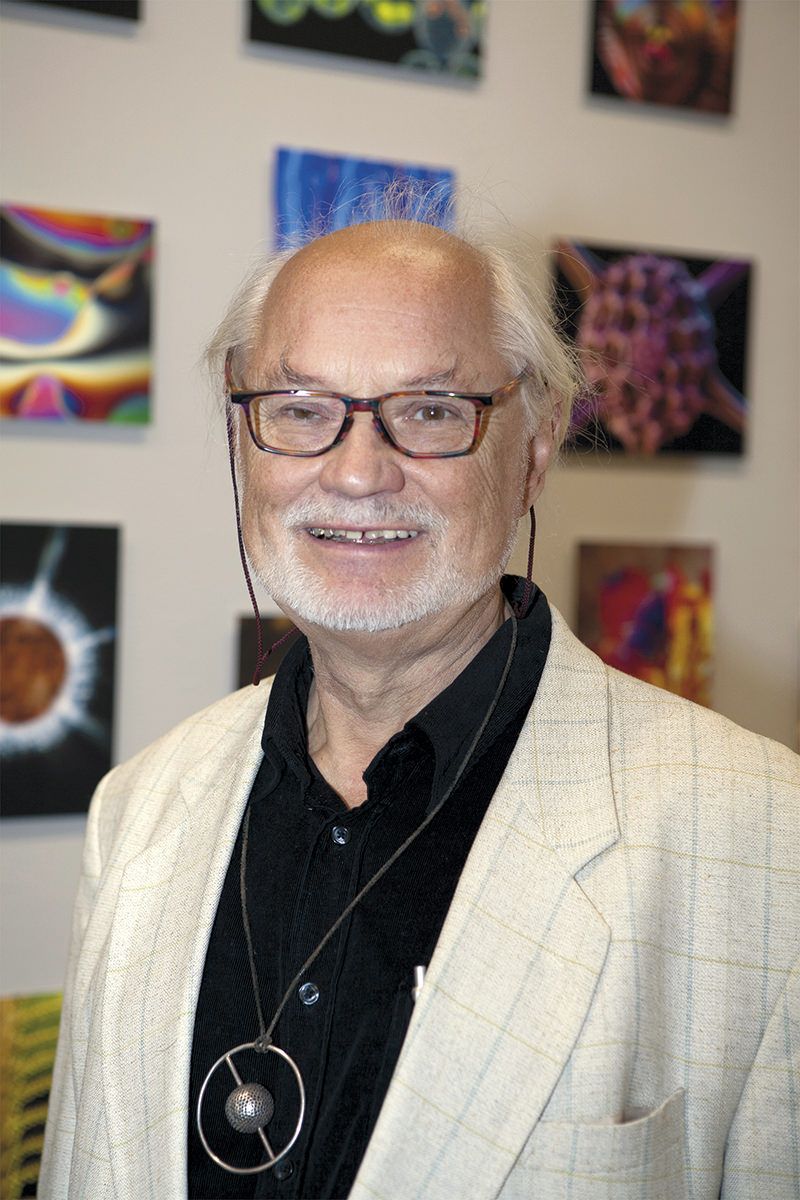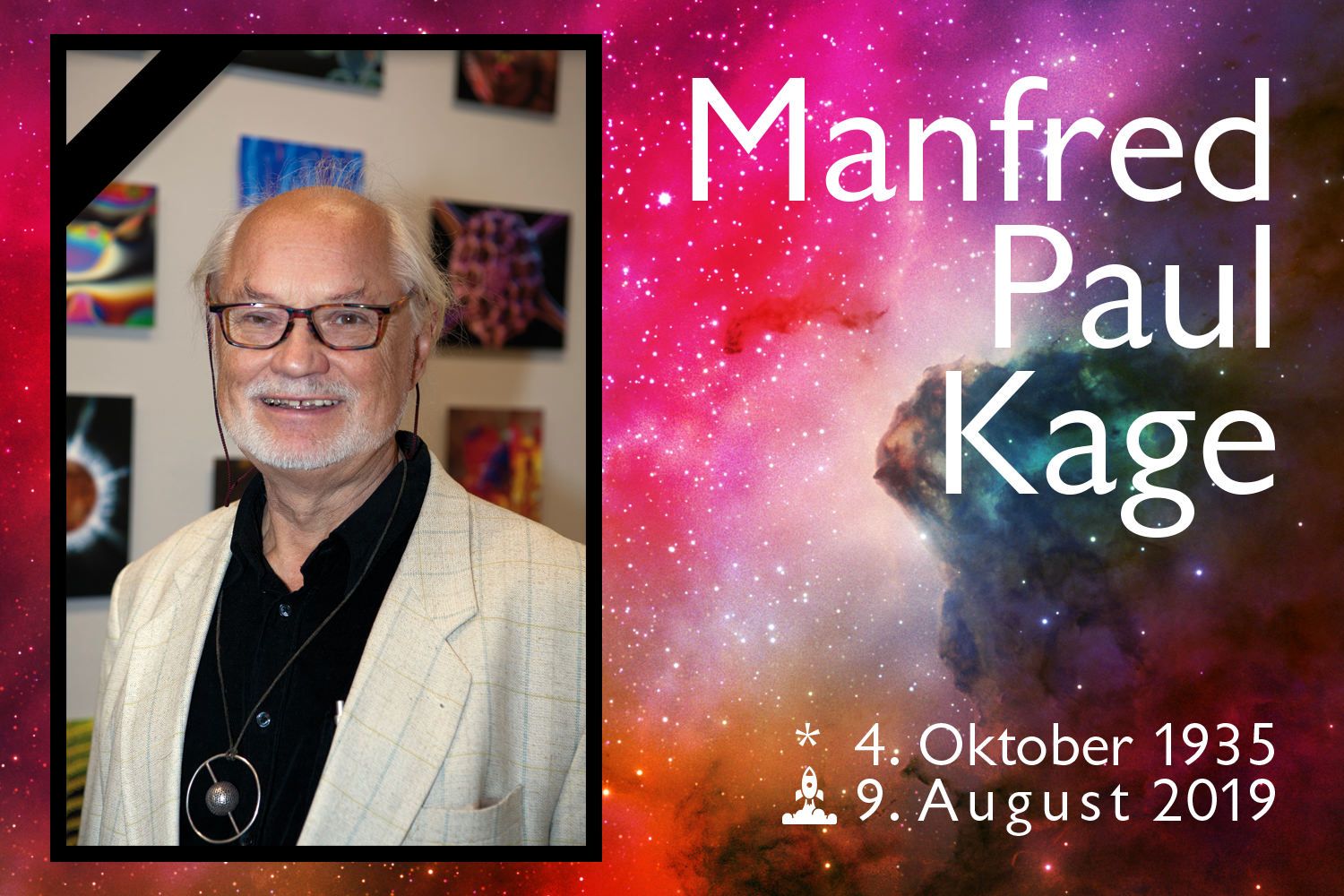"Science Art is the insatiable longing of the white light, broken by terran incarnations appearing iridescent in all colors"
(Manfred P. Kage)
“It was an epiphany for me that things are not what they seem. It was as if the door had opened to a mysterious world - a universe to be explored step by step and insights to be gained.”
(Manfred P. Kage describes the moment when he saw through a microscope for the first time at the age of eight.)

short bio
Manfred P. Kage
Prof. Manfred P. Kage (* 1935 - † 2019)
was a renowned artist, science photographer, filmmaker, and inventor. Cited as one of the most important pioneers of multimedia and video art worldwide, Kage was a visionary and preeminent figure in microphotography since 1956, who also conceived and coined the terms "Science Art" and "Modern Science Art". Kage was a prominent member of the ZERO art movement, who saw a challenge in the depiction of the complexity of the wonders of nature, especially its beauty and ist sensitivity, the "visualization of the invisible" as well as the photographic observation of intelligent natural design. To visually uncover the aesthetics of the tiniest micro-worlds and to bring them to the viewers of his works with innovative techniques had always been Manfred P. Kage's artistically challenging task. With "Science Art" Kage achieved an aesthetic of its own dimension and manifested with this vision his interpretation of the synthesis of science and art. In 1958, Manfred P. Kage had the groundbreaking idea for his "Optical Concert", a multimedia concert played live. Starting in 1965, he integrated the “audioscope" he had invented, a device for making music visible, into concerts. From the 1960s on, he made numerous artistic films, such as in collaboration with his friend Prof. Herbert W. Franke together with Salvador Dalí. Kage also developed video special effects for various science fiction films. In 1971, as a world sensation, he photographed moon rocks from the first Apollo missions in brilliant colour. He achieved this with his 1957 invention, the "polychromator," a kind of optical synthesizer. In 1976, Kage invented colour for scanning electron microscopy and was one of the first science photographers to show moving SEM images. Kage's work has been shown and collected by major museums, including the Olympic Games, the Museum of Modern Art in New York, the Biennale, EXPO and Ars Electronica. The Deutsche Post honoured Kage by publishing his works on the special stamp series "Microworlds". In the 1990s Kage was appointed a visiting professor at the HfG Karlsruhe as well as a member of the DFA (Dt. Fotografische Akademie) and the DGPh (Dt. Gesellschaft für Photographie), which was awarded the Culture Prize. Schloss Weissenstein in Baden- Württemberg, is the seat of Manfred P. Kage's artistic collection and houses the company KAGE GbR, in which his family continues Kage's life's work and visions with a museum and various artistic projects.
“That things are not as they appear was an enlightenment for me, it was as if the door had opened to a mysterious world - to a universe that I wanted to explore and investigate step by step.” Manfred P. Kage quoted during his first look through a microscope at the age of eight-years-old.
"Science Art is the insatiable longing of white light, refracted by terran incarnations, shimmering in all colours" —Prof. Manfred P. Kage
Visually uncovering the aesthetics of the tiniest micro-worlds and bringing the viewers of his works tangibly closer, making the invisible and the hidden visible and merging the microcosm with the mesocosm and macrocosm, Kage had always made it an artistically demanding task . Kage illuminates the unknown and hidden, the exotic ornaments of life and metamorphoses of our world, the inescapable connection of our human existence with nature and the cosmos - embedded in the "all-encompassing rhythm of chaos and order".
Prof. Manfred P. Kage has always made it his artistic and challenging task to visually uncover the aesthetics of the tiniest micro-worlds and to make them tangible to the viewers of his works, to make the invisible and the hidden visible and to merge the micro- with the meso- and macrocosm. Kage illuminates the unknown and the hidden, the exotic ornaments of life and metamorphoses of our world, the inevitable connection of our human existence with nature and the cosmos- embedded in the "all-encompassing rhythm of chaos and order".
Among the most important pioneering works and inventions of Prof. Manfred P. Kage was the "Polychromator", a kind of optical synthesizer for microphotography, invented in 1957, which is still unique worldwide. Dimensionssprung is part of Manfred P. Kages’s "Microverse of Crystals" series, which are crystal-optical pictorial works created with the help of his polychromator.
In 1976 Kage was the first private person in Germany to receive a scanning electron microscope, and in 1977 he developed the first colouring for scanning electron microscopy directly on the instrument with a gammadis discriminator. In 1977, Kage established his multispectral "SEM science art" with this invention and later with spectacular moving SEM images. He was also one of the first science photographers to show moving SEM images.

"Just as a wonderful melody can be heard through different tones, the infinite shapes of crystals as galactic visions allow us to imagine the harmonic structures of the universe. Starting from the big bang, the formation of cosmic nebulae as birthplaces of the first building blocks of life up to visions of flight rich in color and form over the crystal planet with the most extraordinary concrete microforms of the microcosm."
Prof. Manfred P. Kage
Kage is renowned as one of the most important multimedia pioneers worldwide. His groundbreaking invention of the "Optical Concert" in 1958 and ist unique "science art light art visions", Kage and his family artists' collective “Lumation Science Art" continue to span the entire range of optical-visual representations today. As early as 1959, the "Optical Concert" was presented live with effect projectors specially built for this purpose by Manfred P. Kage, similarly to a keyboard in conjunction with music played interactively with it. Kage was considered one of the first multimedia artists, as he performed on live, monumental and multiple projections within architectural structures, stage landscapes, natural spaces and/or on artworks. Combined with musical sound structures, the audiovisual "Optical Concert" becomes a fantastic kaleidoscope of exotic forms and colours of Kage's microscopic worlds in a collective experience directly and immersively perceptible to ist viewers. The "Optical Concert" has already been shown at artistic events on all continents - from the Museum of Modern Art in New York and the Olympic Games, to the Biennale, Expo and Ars Electronica at the invitation of Prof. Herbert W. Franke.

On August 9, 2019, Manfred P. Kage escaped peacefully into another dimension.
For many years he has passed on his visions, his knowledge and his wealth of experience to his wife Christina, his daughter Ninja-Nadine and his son-in-law Oliver Kage and a few years ago he placed the management of his company in their hands with confidence.
Manfred P. Kage worked closely with his family until the very end, created project ideas and new developments for his artistic and scientific work and in this way realized a wide range of projects together with his family.
Dear Manfred, you left us a world-wide life's work that inspires us in every imaginable facet. With this inspiration and in your spirit, we will continue your life's work with the institute for scientific photography, the artistic collection and the museum "KAGEs MICROVERSUM".
We will carry your visions into the world, continue to realize them, courageously explore new, mysterious worlds and report on the fantastic, glowing traces that you have left here on earth.
Christina, Ninja Nadine and Oliver Kage
contact
art collection Manfred P. Kage
KAGE GbR
Christina Kage, Ninja-Nadine Kage
Schloss 1
D-73111 Lauterstein
tel. +49 [0] 7332 4317
www.kage-science-art.de

